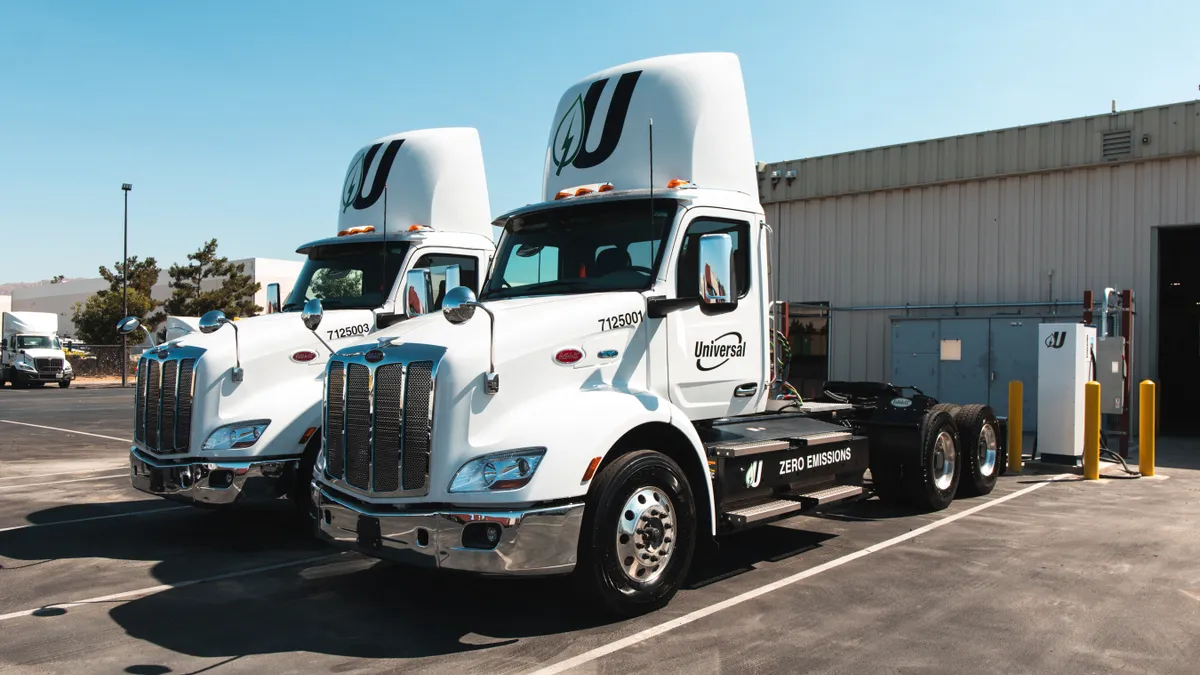This is an opinion piece by ClearFlame Engine Technologies CEO and Co-Founder BJ Johnson, and CTO and Co-Founder Julie Blumreiter. Views do not necessarily reflect those of Transport Dive.
The California Air Resources Board (CARB) recently announced aggressive goals for expanding deployment of zero-emission vehicles over the next 25 years. They're an important first step in mitigating the climate impact of petroleum diesel fuel and improving air quality in low-income urban areas, but CARB also acknowledged the challenges of scaling battery-electric and fuel-cell trucks.
Installing large electric vehicle chargers and hydrogen fueling stations across truck routes, and building a clean-energy grid for supply, are all decades from actualization and thus limit the ability of the trucking industry to decarbonize quickly.
Even under justifiably aspirational projections, CARB acknowledges that, at best, 50% of new trucks in 2035 will be zero emissions, which means the remaining 50% will overwhelmingly rely on diesel fuel — unless other alternatives are developed.
Without a complement to battery-electric and fuel-cell solutions, the world will continue to be reliant on diesel fuel.

This speaks to a sobering reality: Without a complement to battery-electric and fuel-cell solutions, the world will continue to be reliant on diesel fuel.
As such, it is important to also consider solutions that can bring rapid, scalable and cost-effective carbon displacement to the market to address "the other half" of the diesel truck market that will not be electric by 2035.
Alternatives, such as alcohol fuels combined with high-efficiency engines, provide a compelling third leg of the stool, creating an opportunity to reduce emissions quickly through the use of existing liquid fueling infrastructure and a lower operating cost that motivates swift end-user adoption.
Next-generation fuels
Fortunately, low-carbon biofuels are being produced today.
Domestic alcohol fuels already offer a 40% reduction in net CO2 from diesel — a greater net-carbon reduction than using hydrogen fuel cells or battery-electric power, given the current carbon intensity of electricity generation and hydrogen production. (Remember: Just because a truck is electric doesn’t mean the electricity powering it was generated from renewable sources.)
Further, biofuels companies, such as Aemetis, are already producing carbon-negative biofuels. These fuels have the net effect of removing greenhouse gases from the atmosphere as they are used — a significant value proposition for anyone motivated to reduce atmospheric CO2 levels.
California’s Low Carbon Fuel Standard is already well-structured to incentivize the highly sustainable production of these next-generation fuels. Using today's low-carbon biofuels can provide immediate relief from fossil-based carbon emissions, while future production pathways offer carbon mitigation potential that meets or exceeds that of any diesel alternative. And, yes, that includes both battery-electric and fuel-cell vehicles.
Alcohol fuels require lower investment
The largest challenge with electric trucks is not the trucks themselves, but the infrastructure required to recharge them (or to refuel them, in the case of hydrogen).
Infrastructure expansion will require decades and billions of dollars. It is important to begin that investment now, to mitigate climate change; we cannot wait for new infrastructure to be built.
So, solutions with immediate impact are needed.
The U.S. already produces 15 billion gallons of alcohol fuel, with the potential to produce significantly more fuel to displace diesel from the trucking market. This fuel can be distributed through existing infrastructure, and stored and dispensed with low-cost liquid fuel equipment.
Next-generation biofuels — with their potential for carbon-negative impact — can also be immediately deployed through this infrastructure as they become available, meaning that future climate-friendly liquid-fuel technologies can achieve rapid scaling by leveraging today’s production and distribution assets.
New technologies can enable faster market adoption
To achieve rapid market adoption, new technologies must not just be clean but also affordable and minimally disruptive to existing user behavior.
While some fleets will be able to adopt electric solutions quickly, others will not be able to afford the cost and charge time associated with the recharging infrastructure. That means liquid-fueled solutions must address the needs of more typical users.
With technological breakthroughs, some companies are integrating today’s low-carbon fuels with today’s truck engine design to create a product that can be adopted into the market rapidly. The product also address the other 50% of trucks that will continue to need low-cost liquid-fueled operations long-term.
It is important to begin that investment now, to mitigate climate change; we cannot wait for new infrastructure to be built.

Such solutions can be deployed without requiring a cost increase to customers, a change in user behavior or the need for complex infrastructure — all of which will help accelerate market-driven adoption.
Finally, new alcohol solutions offer a range of clean-burning benefits that make them so clean we can eliminate the expensive diesel pollution control systems and still have cleaner air. This enables low-cost pathways for achieving "near-zero smog" emissions that are needed to make an immediate impact on air quality in urban areas, ensuring that vulnerable communities get the rapid relief from pollution that they desperately need.
Every year counts
While the world works toward a clean-air and carbon-free future, every year counts. Regulators, users and producers must consider a range of solutions to meet carbon-mitigation and clean-air goals to ensure rapid carbon displacement and simplified user adoption across a range of applications.
By leveraging the benefits of low-carbon fuels in high-efficiency engines, the transportation ecosystem can begin improving air quality and mitigating carbon emissions immediately, while offering the potential for carbon-negative operation to complement electrification through 2035 and beyond.
To submit an opinion piece for publication on the Transport Dive website, please visit https://www.transportdive.com/opinion/submit-opinion/ and view our guidelines and submission form.




















